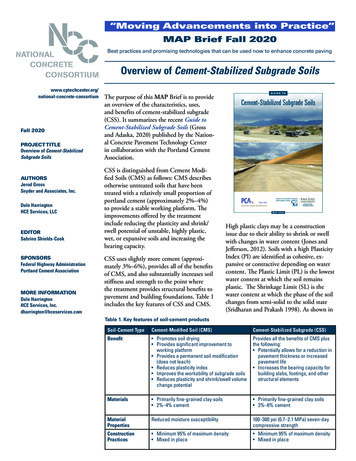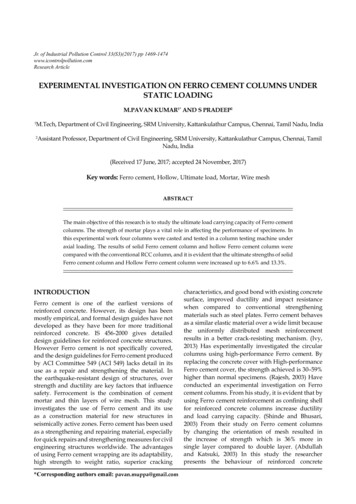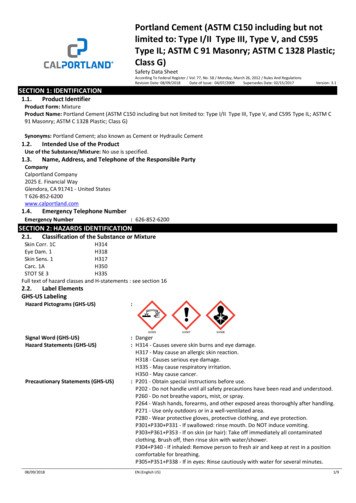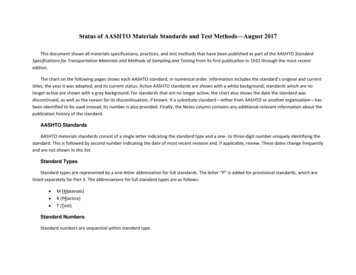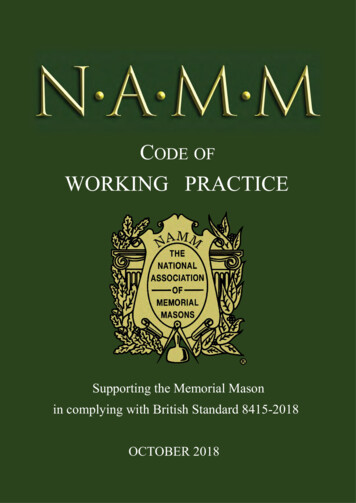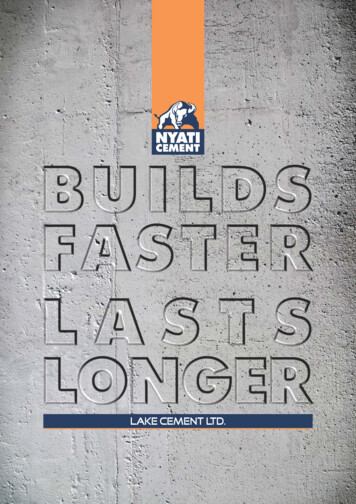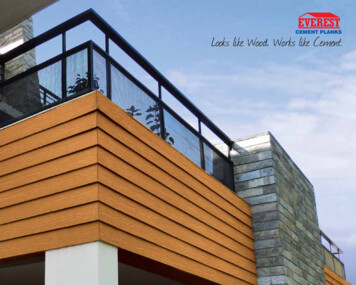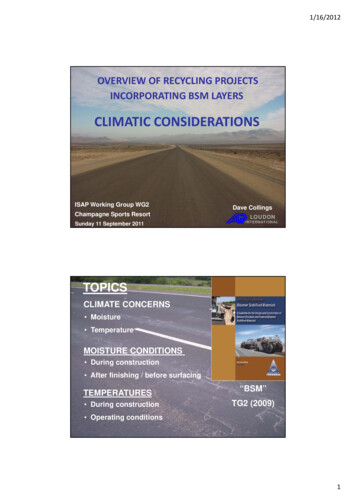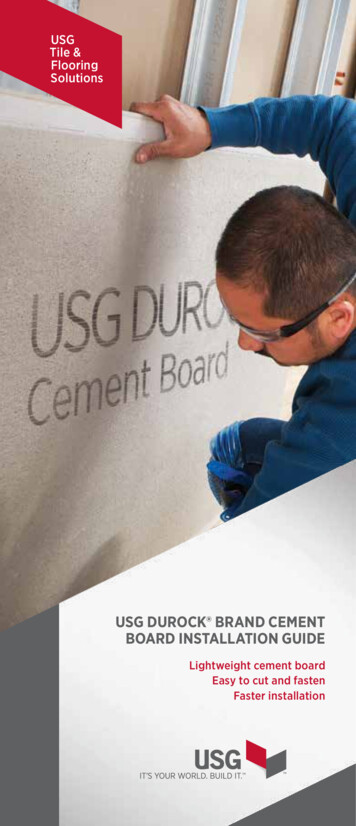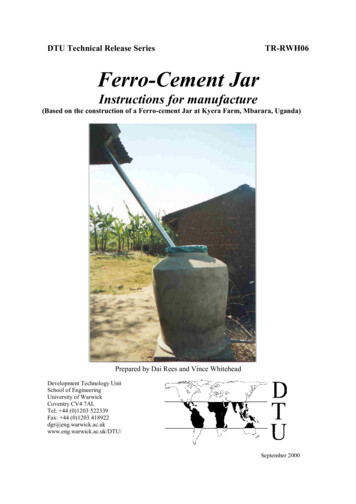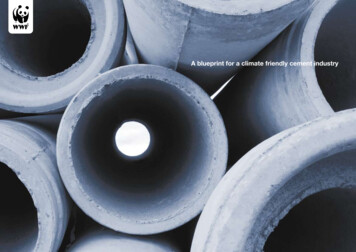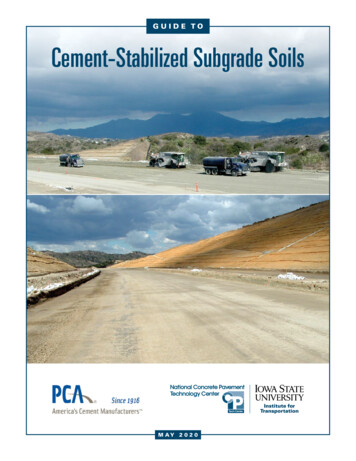
Transcription
GUIDE TOCement-Stabilized Subgrade SoilsM AY 2 0 2 0
About the CP Tech CenterAbout this GuideThe mission of the National Concrete PavementTechnology Center (CP Tech Center) at Iowa StateUniversity is to unite key transportation stakeholdersaround the central goal of advancing concrete pavementtechnology through research, tech transfer, andtechnology implementation.This document, Guide to Cement-Stabilized Subgrade Soils,is a product of the CP Tech Center with funding fromthe PCA. It provides guidance for engineers, producers,contractors, and owners to improve soil properties forconstruction of various types of infrastructure. The focusof this guide is roadway applications.About the PCAReference Information for this GuideThe Portland Cement Association (PCA) is a nonprofitorganization founded in 1916 that serves America’scement manufacturers through policy, research, education,and market intelligence. PCA members represent 91percent of US cement production capacity with facilitiesin all 50 states. PCA promotes safety, sustainability,and innovation in all aspects of construction, fosterscontinuous improvement in cement manufacturing anddistribution, and generally promotes economic growthand sound infrastructure investment.Gross, J. and W. Adaska. 2020. Guide to CementStabilized Subgrade Soils. Portland Cement Association,Washington, DC, and National Concrete PavementTechnology Center, Iowa State University, Ames, IA.DisclaimersNeither Iowa State University nor the Portland CementAssociation nor this document’s authors, editors,designers, illustrators, distributors, or technical advisorsmake any representations or warranties, expressed orimplied, as to the accuracy of information herein anddisclaim liability for any inaccuracies.This publication is provided solely for the continuingeducation of qualified professionals. This publicationshould only be used by qualified professionals whopossess all required licenses, who are competentto evaluate the significance and limitations of theinformation provided herein, and who accept totalresponsibility for the application of this information.Iowa State University does not discriminate on the basisof race, color, age, ethnicity, religion, national origin,pregnancy, sexual orientation, gender identity, geneticinformation, sex, marital status, disability, or status asa US Veteran. Inquiries regarding nondiscriminationpolicies may be directed to the Office of EqualOpportunity, 3410 Beardshear Hall, 515 Morrill Road,Ames, Iowa 50011, telephone: 515-294-7612, hotline:515-294-1222, email: eooffice@iastate.edu. 2020 Portland Cement AssociationFront Cover Image CreditsJeff Wykoff, California Nevada Cement AssociationFor More InformationFor technical assistance regarding cement-based concretepaving, contact the Portland Cement Association or theCP Tech Center:Wayne Adaska, DirectorPavements and Geotechnical MarketsPortland Cement Association200 Massachusetts Avenue NW, Suite 200Washington, DC r Taylor, DirectorNational Concrete Pavement Technology CenterIowa State University2711 S. Loop Drive, Suite 4700Ames, IA techcenter.org
Technical Report Documentation Page1. Report No.2. Government Accession No.3. Recipient’s Catalog No.PCA Special Report SR1007P4. Title and Subtitle5. Report DateGuide to Cement-Stabilized Subgrade SoilsMay 20206. Performing Organization Code7. Author(s)8. Performing Organization Report No.Jerod Gross and Wayne Adaska9. Performing Organization Name and Address10. Work Unit No.National Concrete Pavement Technology CenterIowa State University2711 South Loop Drive, Suite 4700Ames, IA 50010-866411. Contract or Grant No.12. Sponsoring Organization Name and Address13. Type of Report and Period CoveredPortland Cement Association200 Massachusetts Avenue NW, Suite 200Washington, DC 2000114. Sponsoring Agency CodeGuide15. Supplementary NotesVisit https://cptechcenter.org for color pdfs of this and other research reports.16. AbstractThe primary purpose of this guide is to describe the characteristics, uses, and benefits of cement-stabilized subgrade (CSS)and present methods for geotechnical evaluation, mix design, construction, and field testing that will produce a satisfactoryproject. The material in this guide updates and expands on the information presented in the Portland Cement Association’s 2008publication Guide to Cement-Modified Soil (CMS).To clarify the scope of this guide, CSS is distinguished from CMS as follows. CMS describes otherwise untreated soils, particularlyclayey soils, that have been treated with a relatively small proportion of portland cement to provide improved characteristics,including reduced plasticity and volume change potential and increased bearing capacity. CSS not only provides the benefits ofCMS but also substantially increases soil stiffness and strength to the point where the treatment can provide structural benefits topavement and building foundations. Unless stated otherwise, this guide primarily discusses CSS.This guide discusses several critical aspects of CSS. The first two chapters describe the key terminology related to cement-treatedsoil, the effects of cement on the various material properties of the treated soil, the benefits that CSS provides, and the soilproperties and classifications relevant to cement treatment. The third chapter provides a systematic procedure for conducting ageotechnical evaluation and a field sampling and testing program. The fourth chapter outlines a step-by-step mix design processfor determining the proper cement content for a desired application and treated soil characteristics. The fifth chapter summarizesconstruction, field inspection, and testing methods, and the final chapter presents several case studies to illustrate the informationprovided in the guide.Design engineers, testing laboratory personnel, contractors, and owners will find this document useful for determining whetherCSS is appropriate for a particular application and the proper steps to follow to produce a satisfactory project.17. Key Words18. Distribution Statementcement-stabilized subgrade soils—cement-modified soil—soil-cement—subgrade stabilizationNo restrictions.19. Security Classification(of this report)20. Security Classification(of this page)21. No. of Pages22. PriceUnclassified.Unclassified.59NA
Guide to Cement-StabilizedSubgrade SoilsMay 2020AuthorsJerod Gross, Snyder & Associates, Inc.Wayne Adaska, Portland Cement AssociationContributing Technical AuthorsJames Bertsch, Certified Testing ServicesSybil Ferrier, Construction Materials TestingAndrea Marsh, Snyder & Associates, Inc.Technical ContributorsJason Havel, City of Iowa CityDave Panos, City of Iowa City (formerly)Dave Schnickel, Manatt’s, Inc.Technical Editing, Graphics Support, Layout, and ProductionPete Hunsinger, Alicia Hoermann, Sue Stokke, and Oksana Gieseman,National Concrete Pavement Technology Center PublicationsSponsored by 2020 Portland Cement AssociationA guide fromNational Concrete Pavement Technology CenterIowa State University2711 South Loop Drive, Suite 4700Ames, IA 50010-8664Phone: 515-294-5798 / Fax: 515-294-0467https://cptechcenter.org
AcknowledgmentsThe authors, the National Concrete Pavement Technology Center, and the Portland Cement Association gratefullyacknowledge the contributions of the technical contributors and the technical advisory committee (TAC) members,who helped establish the technical direction for the guide and reviewed several drafts. Their feedback and suggestionswere invaluable. Stan Bland, Southeast Cement Promotion Association Garth Benjamin Reese, Raba Kistner, Inc. Brendan Daly, LafargeHolcim Matthew Singel, Cement Council of Texas Marco Estrada, Pavement Recycling Systems Inc. Kimbel Stokes, The Miller Group, Inc. Gregory Halsted, Portland Cement Association David Stowell, New Field Inc. Andrew Johnson, Southeast Cement PromotionAssociation Matt Wood, Ash Grove Cement Company (formerly) David Meyer, Continental Cement Company Brady Pryor, Ash Grove Resources Dane Redinger, Resource International, Inc.ivGuide to Cement-Stabilized Subgrade Soils Blake Wright, Raba Kistner, Inc. Jeff Wykoff, California Nevada Cement Association Corey Zollinger, CEMEX
ContentsAcknowledgments Executive Summary Chapter 1. Introduction Terminology ivix11Soil-Cement 1Cement-Modified Soil (CMS) 1Cement-Stabilized Subgrade (CSS) 1CSS and CMS 2Cement-Treated Base (CTB) 2Full-Depth Reclamation (FDR) 2Resilient Modulus (Mr) 13California Bearing Ratio (CBR) 13Unconfined Compressive Strength (UCS) 14Expansive Characteristics 14Stability 15Sulfate Content 15Soil pH 15Organic Content 162Chapter 3. Geotechnical Evaluation and FieldSampling 17Geotechnical Evaluation 17CSS and CMS 2Field Sampling CSS and CTB 3Types of Field Sampling 19FDR 3Common Field Sampling and Testing Methods 19Summary 3Test Pits 194Coring and Sampling through Existing Pavement 20Cation Exchange 4Auger Sampling 20Particle Restructuring 5Tube Sampling 21Cementitious Hydration 5Standard Penetration Test (SPT) 21Pozzolanic Reactions 5Dynamic Cone Penetrometer (DCP) 21Comparison of CMS, CSS, CTB, and FDR Modification Mechanisms Benefits of CSS 6Other Field Testing Methods 1922Time and Cost Savings 6Falling Weight Deflectometer (FWD) 22Environmental Benefits 6Automated Plate Load Test (APLT) 22Life Expectancy 6Frequency of Sampling 23Chapter 2. Materials and Properties AASHTO Soil Classification System 77Soil Types Improved by the Addition of Cement 8Cement 24Clayey Materials 8Water 24Silty Materials 8Soil 25Clayey and Silty Granular Materials 8Soil Properties and Classification Atterberg Limits 89Liquid Limit (LL) 10Plastic Limit (PL) 10Plasticity Index (PI) 10Shrinkage Limit (SL) 10Effects of Cement Treatment on Atterberg Limits 11Grain Size Analysis (Gradation) 12Sand Equivalent (SE) 13Chapter 4. Mixture Design CSS Materials Step-by-Step Mixture Design 2424251. Determine In Situ Moisture Content and ClassifySoil 252. Determine Cement Type and Estimated DosageRate 263. Determine Chemical Compatibility (If Necessary) 264. Determine Atterberg Limits of Three DifferentCement Content Samples 265. Determine Optimum Moisture Content andMaximum Dry Density 26Guide to Cement-Stabilized Subgrade Soilsv
6. Determine Unconfined Compressive Strength(Optional for CMS) 277. Plot Unconfined Compressive Strength to VerifyCement Content 278. Compile Mix Design Report 28Chapter 5. Construction, Field Inspection, andTesting 29Construction 29Equipment 29Construction Process 291. Moisture Conditioning (If Necessary) 292. Initial Pulverization (If Necessary) 303. Preliminary Grading 304. Cement Application 305. Mixing 326. Achievement of Optimum Moisture Content 337. Compaction 338. Final Grading 349. Curing 34Environmental and Safety Considerations Field Inspection and Testing 34Inspector’s Checklist 34Quality Control 34Chapter 6. Case Studies Case Study 1: Lower Muscatine Road 3535Project Information 35Discussion 35Case Study 2: Los Patrones Parkway 36Project Information 36Discussion 36Case Study 3: Muhlenberg County Airport 37Project Information 37Discussion 37Case Study 4: Des Moines International Airport 38Project Information 38Discussion 38Case Study 5: Wilson Middle School and CentralElementary School vi3439Project Information 39Discussion 39Guide to Cement-Stabilized Subgrade SoilsReferences 40Appendix A. Suggested ConstructionSpecification for Cement-Stabilized SubgradeSoils 421. General 422. Referenced Documents 423. Submittals 424. Materials 425. Equipment 426. Construction Requirements 437. Inspection and Testing 448. Measurement and Payment 44Appendix B. Mix Design Swell Test Methodfor Soil Treatment Using Additives (Cementor Other) 45Section 1. Overview 45Section 2. Apparatus 45Section 3. Materials 45Section 4. Preparation of Sample and Additive 45Section 5. Procedure 45Moisture-Density Relationship 45Swell Testing 46Section 6. Calculations and Graphs 48Section 7. Reporting Test Results 49Section 8. General Acceptance Criteria 49
FiguresFigure 1.1. Structural layers in flexible and rigidpavements 3Figure 5.5. Mixing portland cement and native soil witha reclaimer 32Figure 1.2. Cation exchange 5Figure 5.6. Roadway reclaimer 33Figure 1.3. Flocculation and agglomeration 5Figure 5.7. Vibratory sheepsfoot tamping roller 33Figure 1.4. Cementitious hydration 5Figure 5.8. Smooth drum roller 33Figure 1.5. Pozzolanic reactions 6Figure 1.6. Comparison of CSS with removal andreplacement Figure 6.1. Cement and subgrade being mixed withreclaimer 356Figure 6.2. Vibratory sheepsfoot roller compactingsubgrade 35Figure 2.1. Atterberg limits and phases of fine-grainedsoils 9Figure 2.2. PI of two types of clay soils after beingstabilized with lime or cement 11Figure 2.3. Effects of cement treatment on the Atterberglimits of plastic soils 12Figure 6.3. Reclaimers mixing the subgrade and cement 36Figure 6.4. Compacted subgrade 36Figure 6.5. Weak materials evidenced duringmodification 37Figure 2.4. Sieve analysis apparatus 12Figure 6.6. Mixer incorporating portland cement to adepth of 16 in. 37Figure 2.5. Hydrometer test apparatus 13Figure 6.7. Subgrade after cement application 38Figure 2.6. CBR testing machine 13Figure 2.7. Unconfined compressive strength testingapparatus Figure 6.8. Mixing and compacting cement andsubgrade 3814Figure 6.9. Compacting cement-stabilized subgrade 38Figure 6.10. Mixing cement and subgrade 39Figure 6.11. Constructing foundation for the schoolstructure 39Figure 2.8. Effect of cement on swelling according to aCBR test 15Figure 3.1. Decision tree for developing a CMS or CSSmix design 18Figure 3.2. Test pit 20Figure 3.3. Core sampling of pavement 20Figure 3.4. Auger sampling 21Figure 3.5. Shelby tube sampler 21Figure 3.6. Standard penetration sampler 21Figure 3.7. Dynamic cone penetrometer testing 21Figure 3.8. Falling weight deflectometer 22Figure 3.9. Automated plate load testing apparatus 22Figure 4.1. Mixture design steps for the design path 25Figure 4.2. Maximum dry density and optimum moisturecontent curve for a stabilized clay soil 27Figure 4.3. Example of unconfined compressive strengthversus cement content 28Figure 5.1. Moisture conditioning with a water truck 30Figure 5.2. Spreading dry portland cement 30Figure 5.3. Spreading portland cement slurry 30Figure 5.4. Dust control during portland cementapplication 31Figure 6.12. Completed foundation on cement-treatedsubgrade 39Figure B.1. Untreated soil samples in labeled sealedcontainers 47Figure B.2. Mixing additive and soil in the laboratory 47Figure B.3. Preparing a specimen just after compaction 47Figure B.4. Extruding a compacted specimen from amold 47Figure B.5. Weighing a compacted specimen 47Figure B.6. Measuring the diameter of a specimen 47Figure B.7. Measuring the height of a specimen using amicrometer dial assembly 47Figure B.8. Specimen in a sealed bag 47Figure B.9. Specimen in an oven 48Figure B.10. Oven-dried specimen before weighing andmeasuring 48Guide to Cement-Stabilized Subgrade Soilsvii
TablesTable 1.1. Key features of soil-cement products 4Table 2.1. AASHTO soil classification system 7Table 2.2. Comparisons between AASHTO soilclassification system and USCS 8Table 2.3. Three soil index properties compared to degreeof expansion 10Table 2.4. Effect of cement treatment on the PI and SL ofclay soils 11Table 2.5. Models relating material index and strengthproperties to Mr and CBR 14viiiGuide to Cement-Stabilized Subgrade SoilsTable 3.1. Uses for disturbed and undisturbed soilsampling 19Table 5.1. Typical cement spread rates (US customaryunits) 31Table 5.2. Typical cement spread rates (metric units) 31Table 5.3. Comparison of typical gradation requirementsfor CSS, CTB, and FDR 32
Executive SummaryThe primary purpose of this guide is to describe thecharacteristics, uses, and benefits of cement-stabilizedsubgrade (CSS) and present methods for geotechnicalevaluation, mix design, construction, and field testingthat will produce a satisfactory project. The materialin this guide updates and expands on the informationpresented in the Portland Cement Association’s 2008publication Guide to Cement-Modified Soil (CMS).The use of cement for subgrade soil treatment, whetherthrough CMS or CSS, can be an economical, fast, andsustainable solution to several soil problems encounteredbefore or during construction. Cement treatment canthus help reduce or maintain project timelines andbudgets and minimize the impacts of poor soil onpavement design. Additionally, in both rural and urbanenvironments cement treatment is usually a cost-effectiveand sustainable alternative to removing and replacing soil.CMS and CSS share many characteristics andapplications. Both treatments improve the physicalproperties of the native in situ soil, and both help extendthe life of a pavement by providing uniform support via adurable, stable, and typically non-expansive subgrade.However, to clarify the scope of this guide the twotreatments are distinguished as follows: CMS describes otherwise untreated soils that havebeen treated with a relatively small proportion ofportland cement to provide a stable working platform.The improvements offered by the treatment includereducing the plasticity and shrink/swell potential ofunstable, highly plastic, wet, or expansive soils as wellas increasing the bearing capacity. CSS not only provides all the benefits of CMS butalso substantially increases soil stiffness and strength tothe point where the treatment can provide structuralbenefits to pavement and building foundations.Unless stated otherwise, this guide primarily discusses CSS.While this document may not address all of a project’sspecific details, it provides guidance on the cementtreatment of subgrade soils. Among other topics, thisguide addresses soil classifications and properties,geotechnical evaluation, and the design, construction,and field testing of CSS. Throughout, this guide addressesthe importance of geotechnical oversight at the beginningof a project, during the mix design stage, and duringconstruction in order to ensure that the project meets itsintended purpose.The six chapters in this guide cover the followinginformation: Chapter 1. IntroductionChapter 1 covers the purpose of the guide, keyterminology, a comparison of soil-cement products,soil modification mechanisms, and the benefits and lifeexpectancy of CSS. Chapter 2. Materials and PropertiesChapter 2 covers basic information on soil types andproperties and explains how cement stabilization affectsengineering properties. Chapter 3. Geotechnical Evaluation and FieldSamplingChapter 3 covers the various types of sampling andtesting required to determine soil types and properties. Chapter 4. Mixture DesignChapter 4 covers the process used to determinethe proper cement content required to stabilize thesubgrade. Chapter 5. Construction, Field Inspection, andTestingChapter 5 discusses the process for constructing acement-stabilized subgrade, the equipment required,and the necessary field inspection and testing. Chapter 6. Case StudiesChapter 6 includes five case studies that describeprojects in which cement has been incorporated intothe subgrade to improve soil properties. Each casestudy includes project information and a detaileddiscussion of improvements.The following appendices are included at the end of thisguide: Appendix A. Suggested Construction Specificationfor Cement-Stabilized Subgrade SoilsAppendix A provides a guide specification coveringsubmittals, materials, equipment, constructioninspection, and testing requirements for constructingcement-stabilized subgrade soils. Appendix B. Mix Design Swell Test Method for SoilTreatment Using Additives (Cement or Other)Appendix B describes a test method for determiningthe extent to which engineering properties such asstrength and shrink/swell potential are improved forsoils treated with cement or other additives relative tountreated soil.Executive Summaryix
xGuide to Cement-Stabilized Subgrade Soils
Chapter 1. IntroductionThe primary purpose of this guide is to describe thecharacteristics, uses, and benefits of cement-stabilizedsubgrade (CSS) and present methods for geotechnicalevaluation, mix design, construction, and field testingthat will produce a satisfactory project. The materialin this guide updates and expands on the informationpresented in the Portland Cement Association (PCA)publication Guide to Cement-Modified Soil (CMS)(Halsted et al. 2008).Cement-Modified Soil (CMS)CMS is a compacted mixture of pulverized in situ soil,water, and small proportions of cement that results inan unbound or slightly bound material. The treatedmaterial is similar to a soil but has reduced plasticity anda lower susceptibility to moisture, resulting in a moreworkable material.To clarify the scope of this guide, CSS is distinguishedfrom CMS as follows: Improves the workability of subgrade soils and theirability to be used in construction CMS describes otherwise untreated soils that havebeen treated with a relatively small proportion ofportland cement to provide a stable working platform.The improvements offered by the treatment includereducing the plasticity and shrink/swell potential ofunstable, highly plastic, wet, or expansive soils andincreasing the bearing capacity. Reduces plasticity and shrink/swell volume changepotential CSS not only provides all of the benefits of CMS butalso substantially increases soil stiffness and strengthto the point where the treatment provides structuralbenefits to pavement and building foundations. Promotes soil dryingUnless otherwise noted specifically, this guide primarilydiscusses CSS. Uses on-site soil rather than costly removal andreplacement with select fill materialThis first chapter defines key terminology regardingcement-treated soil, compares four cement treatmentsin terms of their applications and benefits, describes themechanisms by which cement modifies soil, and thensummarizes the benefits and life expectancy of CSS.TerminologySoil-CementSoil-cement refers to a compacted engineered mixtureof soil, cement, and water designed and constructed forvarious pavement and geotechnical applications andcharacteristics. The term soil-cement can be consideredan umbrella term covering the four types of cementproducts defined in the following paragraphs.Note that throughout this guide, the term cementalways refers to portland cement, a hydraulic cementthat sets and hardens by reacting chemically with water(hydration).The principal benefits of CMS are as follows: Reduces moisture susceptibility and migration Increases the speed of construction on sites due to thereduced impact of rain Increases bearing capacity compared to untreated soil Provides a significant improvement to the workingplatform Provides a permanent soil modification (does not leach) Does not require any mellowing periodCement-Stabilized Subgrade (CSS)CSS is a compacted, engineered mixture of pulverizedin situ soil, water, and moderate proportions of cement(slightly more cement than CMS) that results in asemi-bound to bound material. The treated material hasstructural engineering properties similar to or better thanthose of a granular material.In addition to all of the benefits of CMS, CSS providesimproved shear and compressive strength and/or soilshrink/swell tendencies. The degree of improvementdepends on the quantity of cement used and the type ofsoil. Therefore, by the addition of varying amounts ofcement, it is possible to produce cement-stabilized subgradewith a wide range of engineering properties. Typical sevenday unconfined compressive strengths (UCS) for CSS rangefrom 100 to 300 psi (0.7 to 2.1 MPa).Chapter 1: Introduction1
CSS provides all the principal benefits of CMS inaddition to the following: Reduces moisture susceptibility and migration Improves bearing strength and increases CaliforniaBearing Ratio (CBR) Potentially allows for a reduction in pavement thicknessor increased pavement life May be used to support other infrastructure,including rails, airfields, parking lots, and loading/intermodal facilitiesCement-Treated Base (CTB)Cement-treated base (CTB) is a fully bound, compacted,engineered mixture of aggregate, water, and sufficientcement to meet the project-specified minimum durabilityand strength requirements. CTB can be mixed in placeusing on-site soils or mixed in a central plant or pugmillusing selected aggregate. Because of the better aggregateselection available for CTB, it typically uses about thesame quantity of cement as CSS; however, CTB resultsin a stronger, more durable, more frost-resistant layerwithin the pavement structure. Typical seven-day UCSfor CTB range from 300 to 600 psi (2.1 to 4.1 MPa).More detailed information about CTB can be found inthe PCA publication Guide to Cement-Treated Base (CTB)(Halsted et al. 2006).The principal benefits of CTB are as follows (Halsted etal. 2006): Provides a stiffer and stronger base than an unboundgranular base Requires a thinner section for roadway bases comparedto an unbound granular base Provides a moisture-resistant base Provides an erosion-resistant base Improves freeze/thaw durability Provides high strength, even when saturatedFull-Depth Reclamation (FDR)A special case of CTB, full-depth reclamation (FDR) is aprocess that involves pulverizing and blending an existingdistressed asphalt roadway surface and its underlyingbase and/or subgrade materials. Cement is mixed withthe pulverized material, compacted, and cured, resultingin a new homogenous and stabilized base. With respect2Guide to Cement-Stabilized Subgrade Soilsto performance, this method compares favorably tothe complete removal and replacement of a distressedasphalt pavement and underlying granular base material.More detailed information about the benefits, design,and construction of FDR can be found in the PCApublication Guide to Full-Depth Reclamation (FDR) withCement (Reeder et al. 2017).FDR provides all the principal benefits of CTB inaddition to the following: Increases structural capacity for existing roadwayscompared to non-stabilized sections Increases durability compared to granular basematerials Provides substantial cost savings compared to removaland replacement Reduces environmental impacts compared to removaland replacement Reduces truck traffic and improves safety compared toremoval and replacement Allows for faster construction time compared toremoval and replacementComparison of CMS, CSS, CTB, and FDRGiven that subgrade soils are an integral part of anypavement system design (Figure 1.1) and poor subgradesupport is the principal cause of pavement distress, thebenefits offered by any of the four cement treatmentsdescribed above can be crucial to long-term pavementperformance if undesirable subgrade soils are encounteredwithin project limits.CSS and CMSDespite their similarities, CMS and CSS are differenttreatments. The primary purpose of CSS is to improvethe engineering properties of the native in situ subgradesoil so that it behaves similarly to or better than anenhanced, untreated aggregate base with uniformsupport. While CMS also improves the properties ofthe existing subgrade, CSS provides all the benefits ofCMS in addition to reducing moisture susceptibility,permeability, volume change potential, and plasticity andimproving bearing strength. The improved strength thatCSS provides are often considered in pavement designanalysis, resulting in reduced thicknesses for the overlyingpavement courses.
CP Tech CenterFigure 1.1. Structural layers in flexible and rigid pavementsTo determine whether CSS or CMS is a viable candidatefor a project, a routine geotechnical investigation shouldbe performed during the planning stages to determinethe soil profile and various properties of the underlyingmaterial, including moisture content, plasticitycharacteristics, swell potential, and bearing capacity. Ifremediation is required, this information can also helpdetermine the amount of cement necessary to remedy thesoil. Chapter 2 discusses the recommended laboratorytests in greater depth.CSS and CTBThe main difference between CSS and CTB is thatCSS involves mixing cement into an existing finegrained material to improve the properties of theexisting subgrade soil, while CTB provides a higher endstructural base layer and usually, but not always, consistsof predominantly coarse-grained material. CTB is alsodesigned to have higher strengths than CSS and to beresistant to frost and erosion.Because CTB typically consists of select aggregate,it typically requires a similar or lower percentage ofcement compared to CSS in order to achieve the desiredstrength and durability properties. The percentage ofcement required for both CSS and CTB depends onthe type of soil or aggregate, the desired engineeringcharacteristics, and the design of the overall pavementsystem. For instance, a lower percentage of cementwould be required to provide the desired engineeringproperties for a subgrade or base material that consists ofa well-graded aggregate compared to a subgrade or basematerial that consists of a significant amount of clayeyor silty soil.In terms of applications, CSS alone may be used as thedirect support material for concrete pavements, while forflexible pavements an aggregate base is typically placedupon the CSS before placement of the pavement. LikeCSS, CTB may also be used as the direct support materialfor concrete pavements, though an interlayer of asphalt/aggregate base or a geofabric between the CTB and theconcrete may also be included. Unlike CSS, CTB may beused as the direct support material for flexible pavements;however, in such cases precautions, such as limiting thestrength of the CTB or incorporating microcracking intothe CTB, should be considered in order to reduce thepotential for reflective cracking in the
The primary purpose of this guide is to describe the characteristics, uses, and benefits of cement-stabilized subgrade (CSS) and present methods for geotechnical evaluation, mix design, construction, and field testing that will produce a satisfactory project. The material in this guide up
